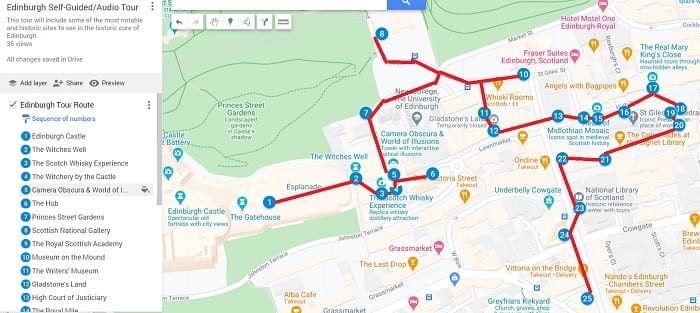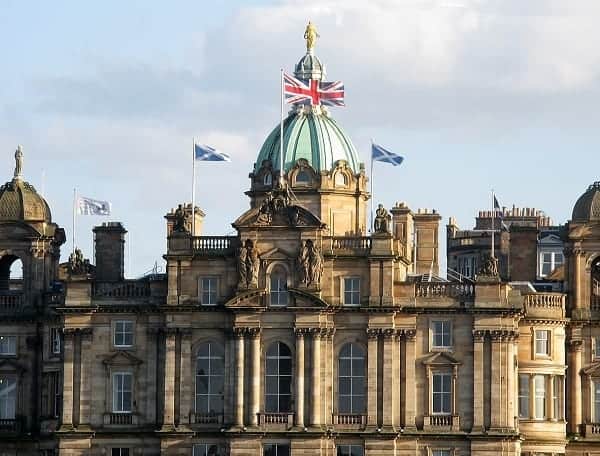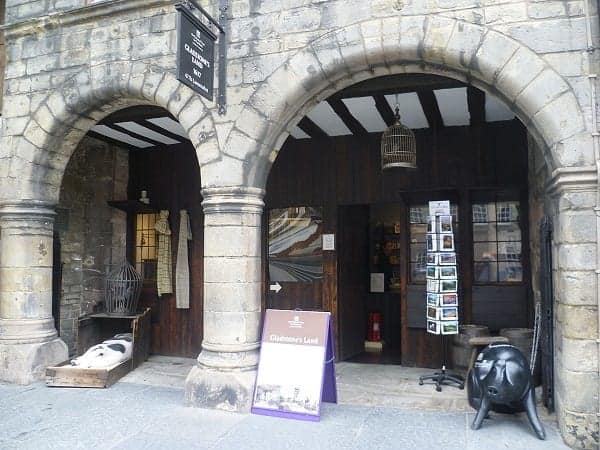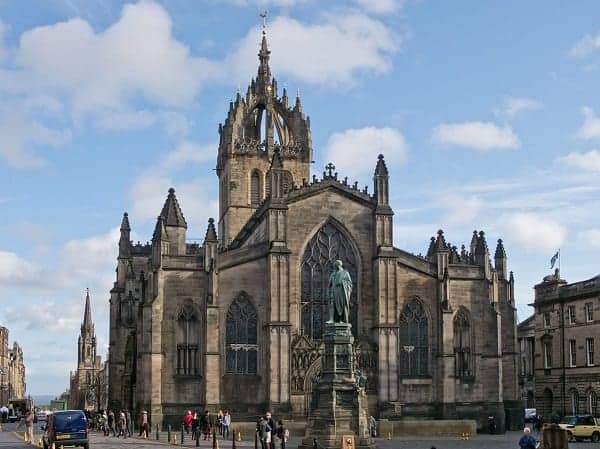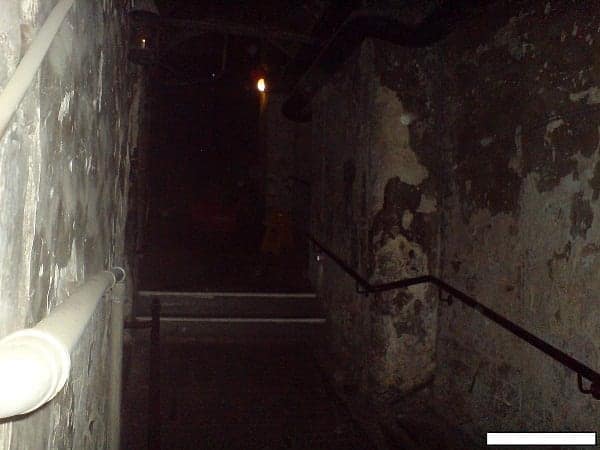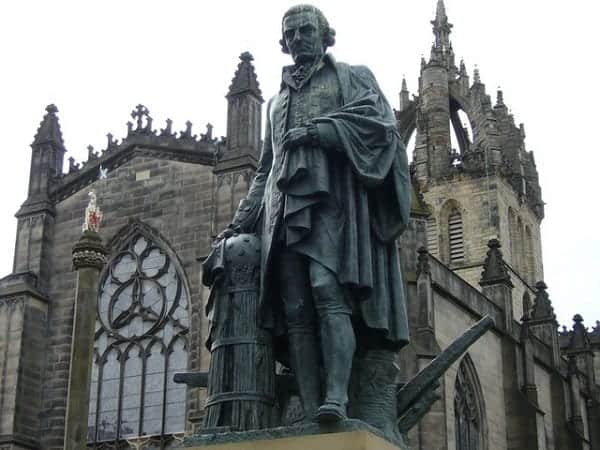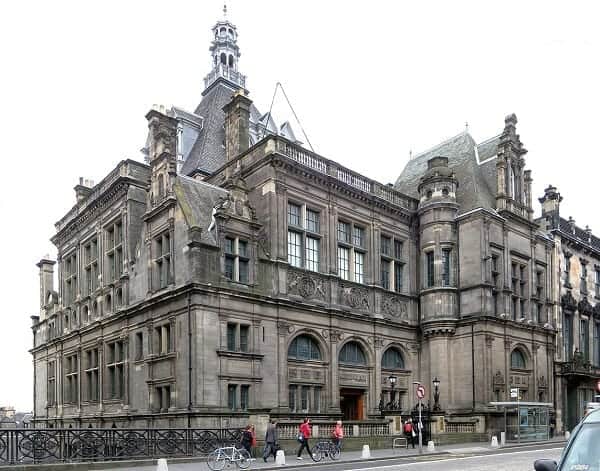This post is a free, self-guided tour of Edinburgh, along with a map and route, put together by local tour guides for Free Tours by Foot.
You can expect to walk nearly 2 miles or just over 3.2 kilometres.
Below is the abridged version. You can get the full version with directions by downloading this map, PDF version, or downloading our audio tour (see below).
Click the map to enlarge it or to download it to your smartphone.
GPS-Enabled Audio Tour
We also offer an audio tour of historic Edinburgh, researched, written, and recorded by one of our own tour guides.
Here’s a sample.
Purchase our Audio Tour of Edinburgh
Additionally, you can also take free guided walking tours that run multiple times each day. These tours are in reality pay-what-you-wish tours.
Edinburgh is one of the most historic cities in Scotland and the entire United Kingdom.
In addition to its medieval history, this city’s history of education and learning has also affected our modern lives.
Whether it be the contributions that Adam Smith made to our modern understanding of a free market economy or the inspiration pulled from Edinburgh for the Harry Potter series, the people and the atmosphere of this city have contributed to the world in many important ways.
This tour will lead you through some of the most influential and popular landmarks in Edinburgh with plenty of sightseeing on the way.
In addition to historic sites, I’ll also point out some options for food, museums, art, and other ways to make the most of your time in Edinburgh.
This tour will begin at Edinburgh Castle and continue downhill, mostly following the Royal Mile, with a few turns onto other streets.
Once you’ve made your way to the castle gates, you’ll be ready to begin this tour.
Edinburgh Castle
This is the most historically significant landmark in all of Edinburgh, and there have been people living in the area since around the second century CE.
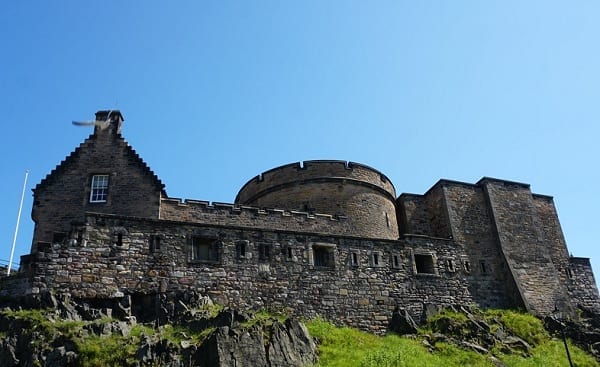
The castle itself became a royal residence in 1124, and it has been through a total of 26 sieges throughout its history.
This makes Edinburgh Castle the most besieged location in Scotland and one of the most attacked structures in the whole world.
This is the home of the Honours of Scotland, also known as the Scottish Crown Jewels. Entry is ticketed, and you can visit every day of the year.
The Castle is open from 9:30 am - 18:00 (6 pm) daily from April - September and from 9:30 am - 17:00 (5 pm) daily from October - March.
Tickets are £17.50 for Adults, £14 for Seniors and Unemployed, and £10.50 for Children. Visit the website.
Kids under 5 get in for free with an Adult. Alternatively, you can save money on tickets using either the Edinburgh Explorer Pass or the Royal Edinburgh Ticket.
GPS-Enabled Audio Tour
We also offer a 25-stop audio tour of historic Edinburgh, researched, written, and recorded by one of our own tour guides, that you could take whenever you wish.
Here’s a sample.
- Purchase an audio tour (£2.30)
- Get a confirmation email with .mp3, pdf, and embeddable Google Map
- Enjoy the tour(s).
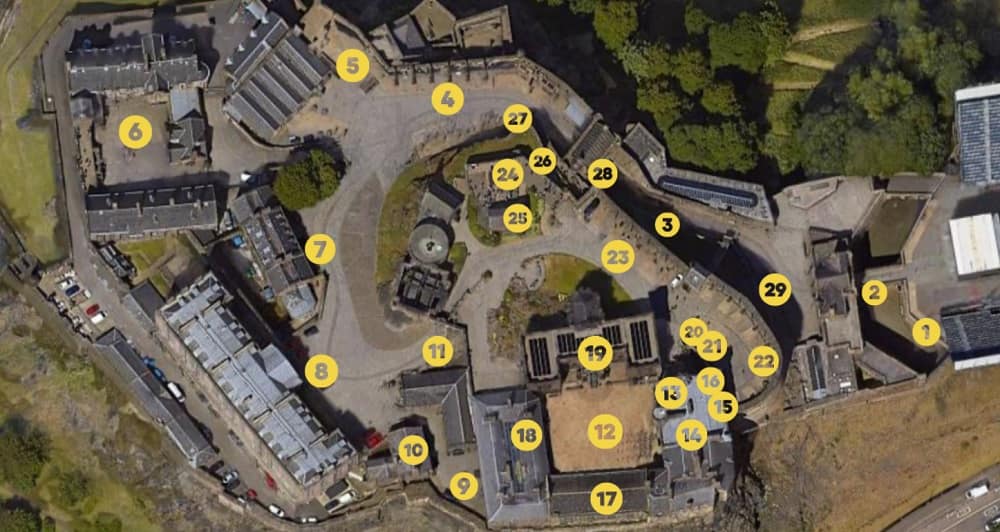
The Witches’ Well
This monument was erected in memory of the more than 4,000 alleged witches who were burned at the stake in front of Edinburgh Castle from the 15th - 18th century.

The plaque features symbolic imagery including a foxglove plant which represents the use of herbal medicine, two heads representing evil and good, and a snake that is representative of both treachery and wisdom.
Many in Edinburgh would like to see an even better memorial, as this one is fairly small and has fallen into disrepair.
Castlehill Attractions
Castlehill is filled with notable attractions, but there are three, in particular, you may want to visit:
- The Scotch Whiskey Experience
- The Witchery
- Camera Obscura & The World of Illusions
The Scotch Whiskey Experience has one of the largest collections of Scotch Whiskey in the world, and it also has a ride that allows you to experience how this drink is made.
The Witchery is an interesting restaurant with 9 theatrical suites that are designed to look medieval. Although prices are high, this is a very popular location for tourists.
Camera Obscura & The World of Illusions is a family-friendly attraction with multiple interactive exhibitions.
It's also home to the Camera Obscura, which reportedly projected moving images 40 years before the motion picture was invented.
Princes Street Gardens & Museums
These beautiful gardens are located right alongside Edinburgh Castle, and there are a lot of great monuments to see in the area.
This is also the location where several local events and festivals take place every year.
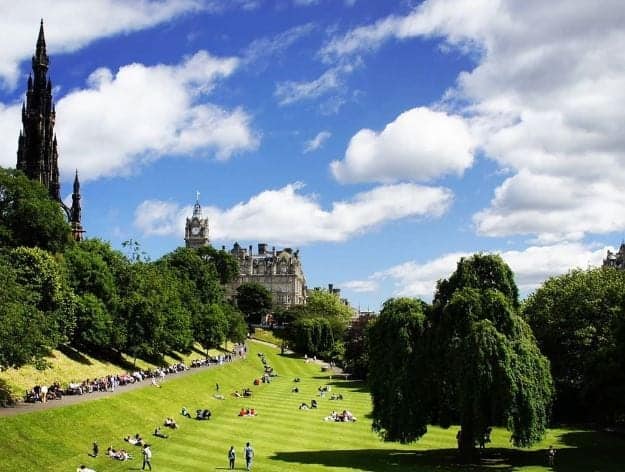
Located across from the Prince Street Gardens, the Scottish National Gallery and Royal Scottish Academy are both beautiful art museums which you can visit for free.
The Scottish National Gallery is especially worthy of a visit because it houses works by Raphael, Claude Monet, and Paul Gauguin.
Museum on the Mound
This is the Head Office of the Bank of Scotland, and it was originally built in 1806.
Although it’s still used by the bank, there is also an interesting museum inside which is free to visit.
The museum focuses on the history of economics in Edinburgh, as well as the money and coinage used in the city over many centuries.
One of the most interesting exhibits is a £1 million note from the Bank of England.
The Museum on the Mound is open from Tuesday - Friday from 10 am - 17:00 (5 pm).
It’s also open on Saturdays and Bank Holiday Mondays from 13:00 (1 pm) to 17:00 (5 pm), and admission is free.
The Writer’s Museum
Housed in a historic building known as Lady Stair’s Close, this museum is dedicated to the lives and works of 3 well-known and beloved Scottish writers: Robert Burns, Sir Walter Scott, and Robert Louis Stevenson.
Robert Burns is known for poems like Halloween and Auld Lang Syne.
Sir Walter Scott is known for the poem The Lady of the Lake and novels like Rob Roy and Ivanhoe.
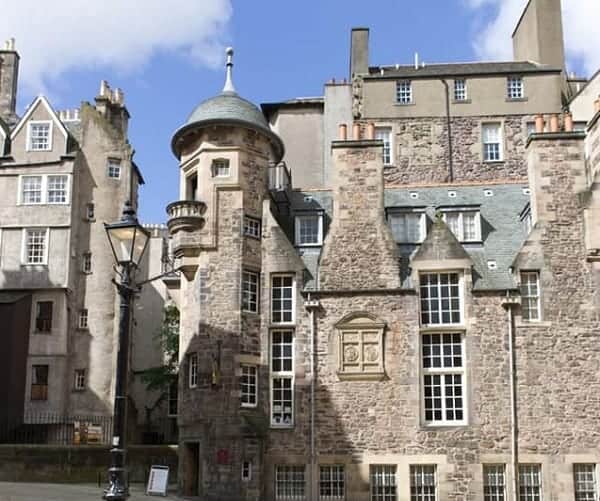
Robert Louis Stevenson is known for novels like Treasure Island and the Strange Case of Dr. Jekyll and Mr. Hyde.
The collection on display here includes portraits, written works, and personal objects owned by the three writers. Admission is free and the museum is open daily.
The Writer’s Museum is open daily from 10 am - 17:00 (5 pm) and admission is free.
Gladstone’s Land
This 17th-century tenement house is one of the oldest buildings on the Royal Mile.
And it has been restored to remain faithful to its roots so that visitors can experience what life was like hundreds of years ago.
Although admission isn’t free, it is fairly affordable and open daily throughout most of the year.
Check out the official website for more information.
High Court of Justiciary
This is the supreme criminal court of Scotland, and even to this day, they hear cases of both criminal trials and appeals.
One of the most interesting things to see here is the statue of David Hume, a philosopher who once coined the phrase “reason is the slave of the passions.”
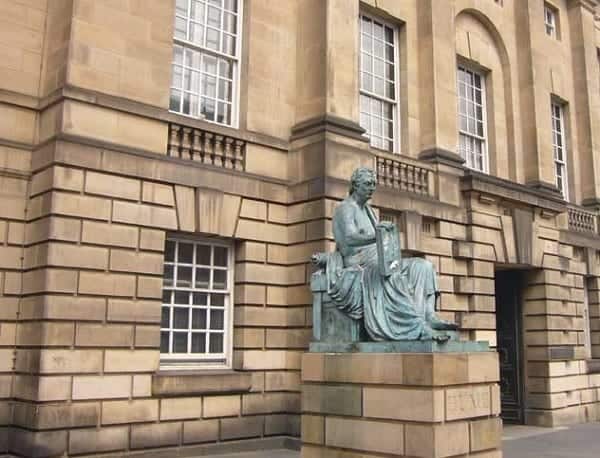
Hume was inspired by the likes of Sir Isaac Newton and John Locke, and he saw philosophy as something that could be scientifically tested and experimented.
Hume inspired many notable figures, including people like Adam Smith and Benjamin Franklin.
The Heart of Midlothian Mosaic
This used to be the site of the Old Tolbooth, an administrative building that was also used as a prison and a site of public executions.
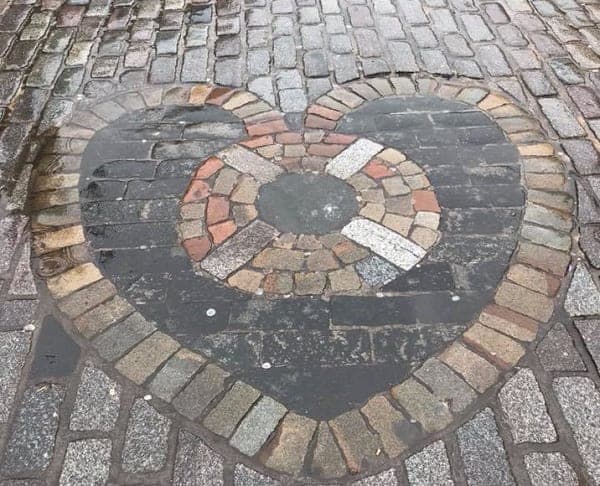
The mosaic that exists here now is named after the Midlothian county, of which Edinburgh was the county town.
It memorializes the location of the jail, and there is an odd tradition of spitting on it for good luck.
While there’s no law against doing this yourself, it’s certainly not the most delightful of customs.
St. Giles’ Cathedral
Although it was founded in the 12th century, this church became an important historical location in the 16th century during the period of the Reformation.
John Knox served as a minister when St. Giles’ became a protestant church in 1559, and he brought the language of the bible to everyday Scots, making it more accessible to the common man.
Although St. Giles was granted cathedral status from 1661-1689, it has been a Presbyterian church since then and is no longer technically a cathedral, but it’s still colloquially known by that name.
The most recent addition is the Thistle Chapel, built in 1909.
This chapel is fairly important, as it is the site of the ceremony where the Queen selects new members of The Order of the Thistle every other year.
The Real Mary King’s Close
This close was a pretty important location during the 17th-century, and it was the site where George Rae once treated victims of the plague using the suit that has since become known as the “plague doctor” attire.
Although parts of the close were demolished and buried during the 18th century, you can now visit daily and tour the close for yourself to see and learn about the area.
Many hauntings have been reported at Mary King’s Close over the years, and as a result, it has become a subject of fascination for believers of the supernatural.
Nowadays, you can get a fully guided tour of the close which is offered daily from 9:30 - 18:00 every 15 minutes.
Tickets are £17.95 for adults.
Adam Smith Statue
Built in 2008, this is the newest statue on the Royal Mile, and it depicts one of the most important Scottish figures in the history of the country.
Adam Smith is well known as one of the fathers of modern free trade economics, and he’s also the author of The Wealth of Nations, which would quickly become influential in American politics.
American founding fathers James Madison, James Monroe, and Thomas Jefferson all spoke very highly of Adam Smith’s ideas.
And it’s clear to see that his economic concepts were important both here in Scotland and in other parts of the world as well.
Mercat Cross
This was once the site where civic proclamations were publicly read to citizens by a town crier, and it was also used for many punishments including hangings and other public executions.
Although the original cross dates back to 1365, it has been damaged and altered multiple times over the years.
Today, a royal unicorn sits at the top with a Scottish flag beside it.
The Mercat Cross is lined with the royal arms of Britain, Scotland, England, Ireland, Edinburgh, Leith, the Canongate, and the University of Edinburgh.
Statue of James Braidwood
Although this figure may not appear familiar, he was actually a pretty important person in the history of Edinburgh and the United Kingdom as a whole.
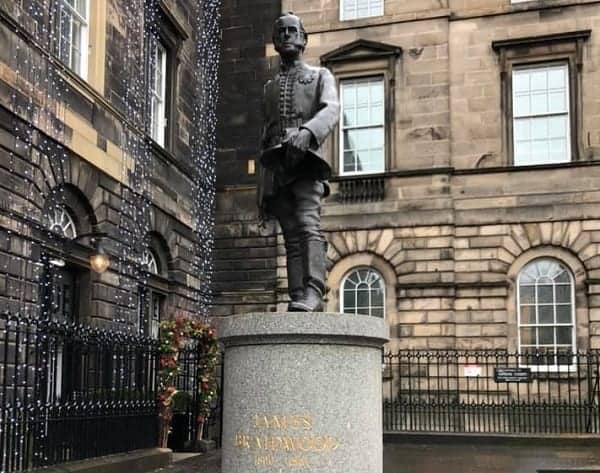
James Braidwood not only founded the first fire service in the city, but he was also the first director of the London Fire Engine Establishment which would come to be known as the London Fire Brigade.
Braidwood is credited with developing modern fire fighting principles that are still in use today.
And he was recognized for acts of heroism during the great fires of Edinburgh in 1824 and London in 1830.
Parliament Square and Old Scottish Parliament
Located behind St. Giles Cathedral, this public square was formed in front of the Parliament House in 1632.
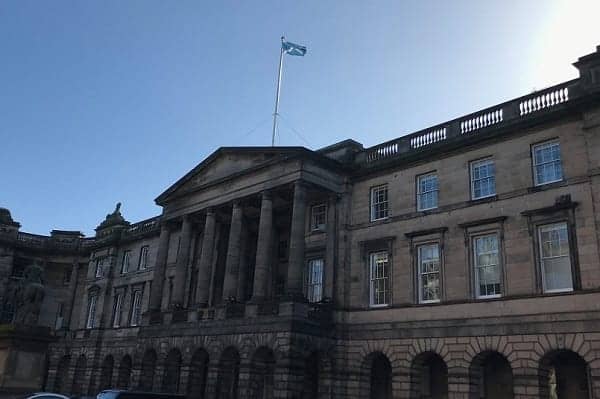
An equestrian statue of Charles II of Scotland stands at the entrance to the Old Supreme Courts of Scotland which is next to the Parliament House on the right.
The Parliament House would only be in use from 1639 - 1707 when it was dissolved as a result of the Acts of Union.
The Acts of Union led to the creation of the United Kingdom of Great Britain.
Edinburgh City Chambers
As you come out from behind St. Giles’ Cathedral, you’ll see the memorial to the 5th Duke of Buccleuch ahead of you and the Edinburgh City Chambers on the left.
This is the meeting place of the City of Edinburgh Council, and these chambers have existed under one name or another since 1753.
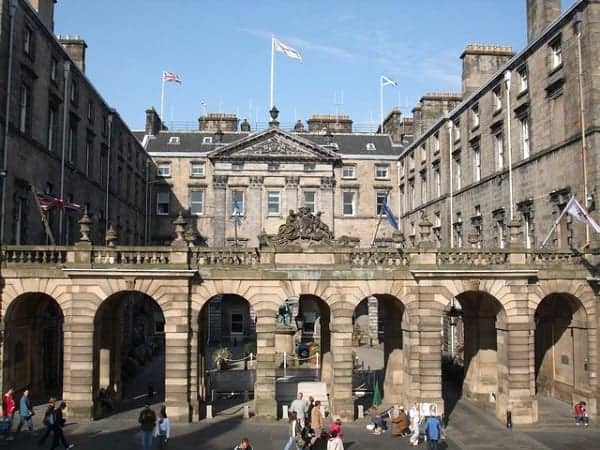
The building here was originally designed to be the Royal Exchange, which led to the partial demolition and burying of Mary King’s Close, as we discussed earlier.
The Royal Exchange was never very popular among merchants, so the Town Council eventually took over the Northern part of the building and used it as the City Chambers starting in 1811.
By 1893, they had taken over the whole building, and it remained home to the city’s council of state for most of the years since.
Its other most important function was as a filming location for the movie Braveheart.
You can also find plaques on the ground with handprints of famous Scots, including J.K. Rowling. This is also a stop on our self-guided Harry Potter Tour.
The National Library of Scotland
Although it was initially opened in 1689, this library would not officially become the property of the nation until the 1920s, at which time it became the National Library of Scotland.
There are more than 26 million items of historic relevance here, and it’s also the home of Scotland’s Moving Image Archive which has over 46,000 videos and films.
Items of note in the library include a letter from Charles Darwin, a Gutenberg Bible, the First Folio of Shakespeare, and more.
Edinburgh Central Library
This was the first public library in Edinburgh, and it was initially built and opened in 1890 with the help of funding from Andrew Carnegie, the wealthy Scottish-American industrialist turned philanthropist.
Upon Carnegie’s insistence, the motto “Let There Be Light” was placed above the entrance.
Above the inner doorway, you’ll find the lintel from the home of Sir Thomas Hope, the owner of the home that was once located on this site before the library was constructed.
The Elephant House
Even though this cafe isn’t particularly old, it has still become a quite notable location in Edinburgh thanks to the famous people who have visited.

Perhaps most notably, JK Rowling is said to have worked on her first Harry Potter novel right here at the Elephant House, and you’ll see all kinds of signs that have been left there by fans.
Authors Ian Rankin and Alexander McCall-Smith also frequented the Elephant House, which makes this a popular stop for budding writers and fans of their work.
National Museum of Scotland
This is a relatively new museum just East of the Greyfriars Kirkyard which combines both the Museum of Scotland and the Royal Scottish Museum.
While the building of the Museum of Scotland opened in 1998, the connected Royal Scottish Museum building opened all the way back in 1866, which is why the museum includes such different architectural styles.
The focus of this museum is the achievements of Scotland and its inhabitants, including examples of art, science, technology, and historical artifacts.
Exhibits include Dolly the sheep -- the first successfully cloned mammal, one of Elton John’s suits, a kinetic sculpture known as the Millennium Clock, and many more.
Admission is free and they are open daily from 10:30 - 16:30 (4:30 pm). Advanced online booking is required.
Greyfriars Kirkyard
Although this graveyard dates back to 1562, it has more recently become known as one of the locations where JK Rowling may have gotten a few ideas for the names of her characters.
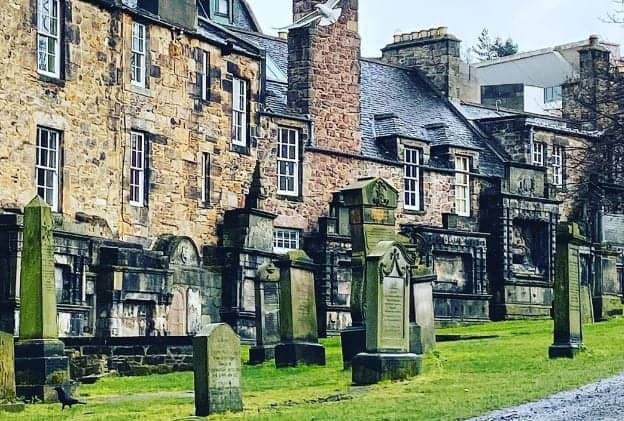
This is also the location where the dog that would come to be known as the Greyfriars Bobby would stay by the gravestone of his deceased owner for 14 years until he also passed away.
Whether you’re a fan of Harry Potter, loyal dogs, or historic headstones, there’s plenty to see and experience at Greyfriars Kirkyard and it’s open from Monday - Friday.
Admission is ticketed, but it is very affordable.




